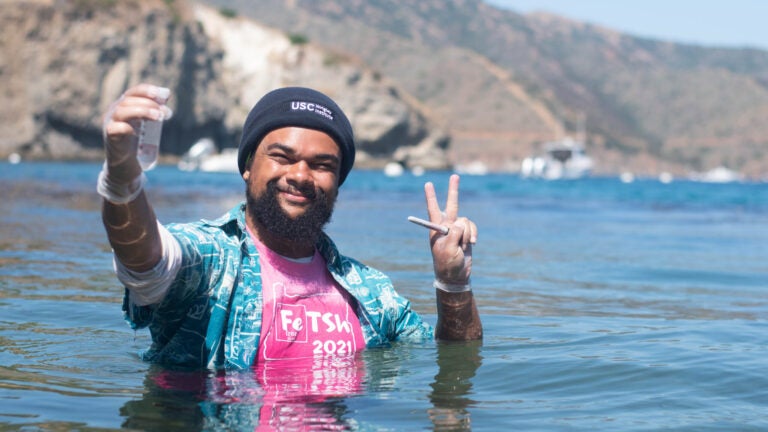
Justin Gaffney takes at the kelp/seawater interface at the Wrigley Marine Science Center waterfront (Jason Goode/WIES)
Understanding macroalgae stress through metal sequestration and impact on local biogeochemistry
Hello, my name is Justin Gaffney and in a few weeks I will begin my fourth year in the Ocean Sciences Graduate Program as a member of the Moffett lab at USC. While I enjoyed visits to Catalina Island each of the previous years (save for 2020) I was blessed to be included as a Wrigley Summer Fellow for 2023.
The Moffett lab is interested in the biogeochemistry of the ocean, which is a fancy way of describing the dynamics between life and inorganic compounds in the ocean that are under the influence of Earth’s processes. To elaborate on this research, we are interested in the trace metal chemistry of the inorganic compounds needed for the survival of biological life. Jim, my advisor, has given me the freedom to connect my research passions to his lab work, allowing the opportunity to study macroalgae and the metal interactions associated with kelp forests.

Macroalgae refer to the many species of seaweeds found throughout the world’s coasts. These organisms, like the smaller diatoms and microalgae, play a crucial role in converting solar energy into organic fuel through primary production. The larger nature of the algae allow certain species to grow into “forests” along temperate high-energy coasts, providing ecosystem services in a way similar to coral reefs in tropical waters increasing species richness. Among the macroalgae, kelps are considered some of the most commercially viable and economically important. This is due to the large size members of these seaweeds can quickly grow such as the California Giant Kelp and the nutrient richness they contain such as in oarweed and sugar kelp.
If we want to reduce the pressures we are putting into Earth’s energy budget we must work towards creating and securing a sustainable future for these crucial kelp ecosystems. Developing and funding a successful blue economy requires a balancing act in which we translate innovations developed by coastal indigenous cultures (much of which have been lost to history with new technological advances that still allow for economic profit but not at the cost of the greater community of life that benefits from these ecological services.
We are sadly aware of the price these underwater forests are paying for the changing conditions of our planet as we have noticed a great decline of around 40-60% globally over the last 50 years. As the kelps are adapted to temperate nutrient rich waters, heating events are believed to drive most of the kelp forest damage. Temperature variability and pollution appear to introduce a wide array of indirect effects on these kelp systems by altering the water quality, introducing thermal and nutrient stress. I am interested in how these kelp forests are responding to seasonal and temporal variation with respect to temperature, nutrient and photooxidative (light induced oxidative stress) changes. If these changes are found to have a significant effect on the uptake of nutrients in kelps, we may be at risk of losing these great kelp forests to other stress tolerant macroalgae communities or lose even entire macroalgal reefs to urchin barrens.
Collections of kelps on Catalina Island have taken some work to develop a system of gathering and then starting dehydration the same day back on campus but I have enjoyed the duality it gives in letting me work a little bit at each when needed. Thankfully I have not been alone at this task. Ian Osborne, the REU student working with the Moffett lab this summer, proved quite proficient in trace metal clean procedures in our lab, giving improved reliability between samples. We started the digestion of kelp samples collected around Catalina Island and the Port of Los Angeles and quantitated metal counts, then compared with metals found present in the collected seawater.
Having some time away from both laboratory and fieldwork has allowed me to dive into the literature of the seaweeds and build up on the biology and natural history of Southern California. During this search two names, Gerald J. Bakus and E. Yale Dawson, were repeated through much of the literature. Learning about their great works and contributions to not only seaweed ecology and physiology but also the natural history of so much of the California coast has been a rewarding experience all in its own and deepened my admiration for the former professors and researchers that have contributed heartily to the USC community and carry on in the fond memory in those who remain.
Justin Gaffney is supported by the Victoria J. Bertics Graduate Fellowship Fund.